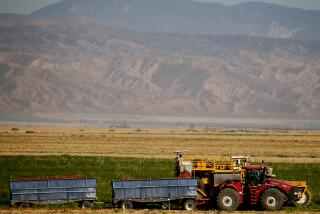THE CALIFORNIA DROUGHT : Cotton, Rice, Sugar Beet Growers Seek U.S. Disaster Relief
- Share via
WASHINGTON — California producers of rice, cotton and sugar beets appealed Thursday for federal disaster relief to offset sharply reduced plantings and yields expected this year because of record drought.
Rep. Gary A. Condit (D-Merced) said at a congressional hearing that the cutbacks in cotton production alone could result in a $1-billion loss to the state’s economy.
Existing farm subsidy programs, however, may offset much of the lost income of rice and cotton growers, and Congress is expected to allocate funds this year to carry out a disaster relief provision in the 1990 farm law.
As a result of the smaller harvests, cotton prices could rise as much as 5 cents a pound, and rice prices could go up by 30 to 50 cents per hundred pounds, according to Agriculture Department estimates. Since there is a surplus of sugar, and sugar beets grown in California account for less than 9% of the national harvest, their price is not expected to increase because of the drought.
“Conditions are absolutely desperate,” Rep. William Thomas (R-Bakersfield) told a House Agriculture subcommittee on rice, cotton and sugar beets chaired by Rep. Jerry Huckaby (D-La.).
“There should be a congressional role in helping you (Californians) through this critical period,” Huckaby replied.
Daniel A. Sumner, deputy assistant secretary for economics for the Department of Agriculture, said there was little chance of substantial improvement in California’s drought crisis this year despite recent heavy rains over most of the state.
While noting that the situation is far from certain, Sumner predicted that “sharp acreage cutbacks” are likely for rice, cotton and sugar beets in the current crop year. He provided the following breakdown of California plantings, production and prices:
Rice: An expected reduction in plantings from 390,000 acres last year to about 250,000 acres this year, with output lowered from 29.3 million hundredweight (100 pounds) in 1990 to between 17 million and 20 million hundredweight, or 40% below the previous year’s output.
While rice growers’ income generally will be protected by existing farm programs, millers and other industries related to rice processing and marketing face large losses. In the worst case, rice prices could climb 6%, or 30 cents to 50 cents per hundredweight.
Cotton: Plantings may be cut by 30%, from 1.1 million acres last year to 800,000 acres this year, although some private analysts said the total may fall to as little as 500,000 acres. The California crop--estimated at 2.8 million bales in 1990-91--may drop to 2 million bales or less. Cotton prices may rise by several cents a pound, perhaps as much as five cents.
Sugar beets: Acreage in production--already down because of the drought--may be cut by another 10% to 15% because of water shortages. But the large surplus of sugar means that the additional cutback in California beet production will have no significant effect on prices.
In other testimony, William V. Huffman of the Farmers’ Rice Cooperative of Sacramento predicted that the state’s rice crop would be about 65% of normal, with plantings of 250,000 and 275,000 acres. Very little, if any, rice will be grown in the San Joaquin Valley this year, Huffman said.
Huffman said there was surprisingly little enthusiasm among rice farmers for state efforts to get them to sell their water rights to a water bank that would be used to increase flows to urban areas, even though the initial offers have been attractive.
“Growers are saying they are in no mood to sell out their communities (dependent on rice crops for a livelihood) for a quick buck,” Huffman said.
Tommy R. Funk, chairman of the National Cotton Council, forecast a loss of $300 million from sharply reduced planting in the state due to the drought. Speaking on behalf of California cotton growers, he appealed to Congress to allocate funds to offset the drought’s impact on crops.
Funk said the government would save money on subsidy payments because of higher prices and said the savings should be diverted to disaster relief.
George A. Lambert, chief executive officer of Spreckels Sugar Co., suggested that the government provide five-year, low-interest loans for distressed sugar beet processors and five-year tax credits for investments in water conservation measures by growers.
CROP CUTBACKS
Because of reductions in the number of acres planted during the drought, the price of some of California’s water-thirsty crops may increase. Here are three key crops that are affected by the recent water cutbacks.
% Acreage Price Increase Crop Reduction From 1990 Rice 35% Up to 50 cents per hundred pounds Cotton 30% Up to 5 cents per pound Sugar beets 10% to 15% No increase
Source: U.S. Department of Agriculture
More to Read
Sign up for Essential California
The most important California stories and recommendations in your inbox every morning.
You may occasionally receive promotional content from the Los Angeles Times.










